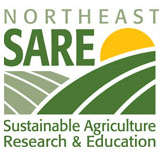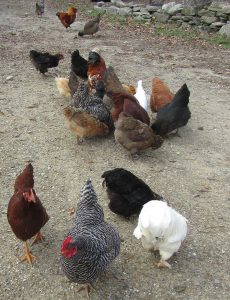Bulletin #2216, Pros and Cons of Poultry Swaps in New England
Prepared by a group of Agriculture Service Providers from the six New England States
Edited by Principal Investigator, Richard Brzozowski, University of Maine Cooperative Extension
For information about UMaine Extension programs and resources, visit extension.umaine.edu.
Find more of our publications and books at extension.umaine.edu/publications/.
Chicken swaps or poultry swaps are quite popular in different parts of the country. A poultry swap is an organized event at which poultry keepers sell live birds of various species to others — typically “swapping” birds for cash. Poultry equipment might also be sold at some swaps. These swaps are sometimes hosted by poultry clubs or by farm and feed retail stores. They could occur at any time of year but are more likely to be scheduled in the spring and summer months.
There is a risk in participating in such swaps. The risk is higher for buyers than for sellers. Below is a list of the advantages and drawbacks of participating in a chicken swap. Weigh these points when considering your possible participation. Are the benefits worth the possible risk? Are there less risky methods of obtaining birds?
Pros
- Poultry swaps allow people who raise live birds to market them on a small scale. Sellers have the opportunity to generate income through sales.
- Interaction and networking of poultry keepers take place at poultry swaps.
- There is an opportunity to learn more about poultry at swaps.
- In states where sale records of live poultry are required, these sale records from poultry swaps could be helpful for tracking disease if there is an outbreak in the area.
- In states where Pullorum-tested birds are banded, a bird for sale with a leg band should reflect that it has been tested.
- Besides birds, vendors can sell poultry related supplies, tools or equipment.
- Licensing of certain locations (host sites) may help to reduce risk. A license reflects an awareness of the event by the agency overseeing animal health in the state.
Cons
- Poultry swaps provide an opportunity for possible disease transmission. If you are a buyer, you could be bringing home diseased stock. These could include internal parasites, external parasites, and Mycoplasma and other diseases.
- Some states do not require testing, licensing or inspection of the site or the birds at swaps. The risks of disease transmission are likely higher in these situations.
- Multi-species interactions typically occur at swaps, e.g. chickens, turkeys, waterfowl, and game birds. This could increase disease risk.
- Buyers usually do not know the histories of bird(s) to be purchased. This includes the conditions in which they were raised, immunization history, and the health of the other birds on the premises.
- Animal welfare could be an issue for those birds being sold. This could include issues related to
- transport conditions;
- lack of food or water;
- extreme temperatures during day of sale; or
- a new home (pen) for the poultry may not be totally prepared.
- Guidelines for good health might not be followed.
- Seller may easily deceive buyers regarding breed, pedigree, health, sex of the bird, age, etc., and this misrepresentation could be costly.
- There would likely be no record or receipt for cash sales.
- Buyer may not be aware that they should quarantine new birds when introducing them to their home flock.
Suggestions when buying birds at a swap
- Do not make hasty purchasing decisions. Avoid impulse buying.
- Plan ahead. Have a clean quarantine pen set up with proper bedding, feed (species-specific), clean feeders, and clean waterers for new birds. This pen should be separated from your own birds (different building or different end of the building).
- Bring a clean crate (or vented box) of adequate size for transporting your newly purchased birds.
- Only buy birds from reputable sellers.
- Ask questions of the seller. Questions related to the bird’s sex, age, breed, parentage, and health should be asked.
- Inspect birds thoroughly before purchase. Check birds’ eyes, feet, feathers, vent, and overall condition. Look for clean, healthy birds. Look for signs of external parasites. Look for signs of stress. Listen for clear and normal breathing. Look for signs of poor management.
- When handling birds, wear clothing (gloves, overalls, coveralls, coat, footwear) that will be laundered and cleaned when returning home; you may wish to put outer clothing worn when handling birds into a sealed plastic bag to transport it home.
- If purchasing the bird, obtain the seller’s contact information. Ask for the brand and type of feed used for the bird.
- After purchasing the bird(s), take photos of each bird purchased. Keep a written record of the condition of each bird.
- Quarantine (separate) your new birds for at least 3 weeks from all other birds on your home/farm. Monitor new birds for any health issues. This does not guarantee that you do not have a bird carrying a disease but somewhat reduces the risk.
- When doing your poultry chores during the quarantine period, perform chores of your own birds first before interacting with newly introduced birds. Use proper biosecurity measures between different bird groups.
Suggestions when buying equipment at a swap
- Thoroughly inspect the equipment before purchase.
- When transporting the equipment, bag it in a large plastic bag or keep it separate from birds and people.
- Upon arrival at your farm, keep all equipment out of the barn or facilities where birds are kept. Before using the equipment, use a brush to wash all equipment with soap and water. If a pressure washer is available, use it on the equipment. Remove all manure or any build up of matter from the equipment. After washing, thoroughly disinfect the equipment with a 5% bleach solution or use a farm disinfectant according to the label instructions. Allow the equipment to air dry.
Reviewed by Extension Poultry Specialists, Dr. Paul Patterson, Pennsylvania State University and Dr. Jacqueline Jacob, University of Kentucky, and Anne Lichtenwalner, DVM Ph.D., of the University of Maine.

This project was supported by Northeast SARE of the USDA National Institute of Food and Agriculture (NIFA), Project number: ENE14-131.
Information in this publication is provided purely for educational purposes. No responsibility is assumed for any problems associated with the use of products or services mentioned. No endorsement of products or companies is intended, nor is criticism of unnamed products or companies implied.
© 2015
Call 800.287.0274 (in Maine), or 207.581.3188, for information on publications and program offerings from University of Maine Cooperative Extension, or visit extension.umaine.edu.
In complying with the letter and spirit of applicable laws and pursuing its own goals of diversity, the University of Maine System does not discriminate on the grounds of race, color, religion, sex, sexual orientation, transgender status, gender, gender identity or expression, ethnicity, national origin, citizenship status, familial status, ancestry, age, disability physical or mental, genetic information, or veterans or military status in employment, education, and all other programs and activities. The University provides reasonable accommodations to qualified individuals with disabilities upon request. The following person has been designated to handle inquiries regarding non-discrimination policies: Director of Equal Opportunity and Title IX Services, 5713 Chadbourne Hall, Room 412, University of Maine, Orono, ME 04469-5713, 207.581.1226, TTY 711 (Maine Relay System).


